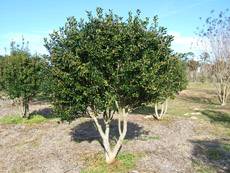Ilex cornuta 'Burfordii' (Burford Holly)

*Click on picture for more images of this species.
- USDA Hardiness Zone: 7A - 9B (10A maybe)
- Mature Height: 15 to 25 ft
- Mature Spread: 8 to 15 ft
- Growth Rate: Moderate
- Availability: Generally available
- Drought Tolerance: High
- Salt Tolerance: Moderate
- Light Requirements: Full sun to partial sun
- Native Origin: Not native to North America. Non-invasive.
- Soil Drainage: Tolerates well-drained sites to sites with extended flooding.
- Foliage: Evergreen tree with no showy fall color.
- Flowers: White, not showy flowers in the spring.
- Pests: Can be plagued with severe infestation of tea scale and tar spots.
Description: Burford Holly is a dense evergreen shrub or small tree with glossy, dark green leaves, each with a single terminal spine. Leaves are among the glossiest and darkest green of trees. The somewhat-showy clusters of fragrant, springtime, white flowers attract bees. The large, bright red, long-lasting berries during the fall and winter provide a nice contrast to the dark green leaves. The plants are self-fertile and do not need a male plant located nearby for pollination. It is one of the most popular shrubs in some areas of the country.
Although typically pruned for formal hedges, the large form and gracefully drooping branches of Burford Holly make it ideal for unpruned natural plantings or as a specimen for spacious areas and large buildings. There are better plants for pruning into formal hedges. Burford Holly can also be trained as an attractive vase-shaped multi-stemmed small tree. Trees trained in this fashion often have a thick crown comprised of many branches and trunks. Burford Holly should be grown and used in this fashion more often. Growing best in rich, well-drained, slightly acid soil, Burford Holly does well in full sun or part shade. However, flowering and subsequent fruiting is reduced in shady locations.
Burford Holly is drought-tolerant and easy to grow once established. It is well suited for low-maintenance landscapes which receive little or no irrigation or fertilizer after trees are established. Once the tree reaches 10 or 15 feet tall, growth rate slows.
Gainesville Observations: Trees came to us with a well developed canopy of dense branches resulting from shaping and shearing in the nursery. This appears to be a suitable technique for growing and marketing this tree. Other than irrigation, we have done nothing at all for these small trees. I have seen great examples of this tree growing nicely in parking lot islands and other small spaces.
Fact Sheet (pdf)
Click here for more photos of this tree.

